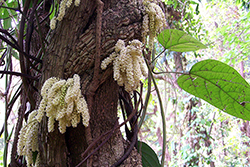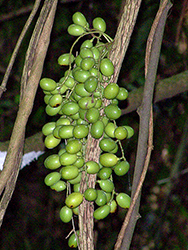e-Flora of Thailand
Volume 5 > Part 3 > Year 1991 > Page 304 > Menispermaceae > Tinomiscium
Tinomiscium petiolare Hook.f. & Thomsonwfo-0001238609
Fl. Ind. 205. 1855; Hook.f. in Fl. Br. Ind. 1: 97. 1872; Gagnep. in Fl. Gén. I.-C. 1: 127, t. 14/1–10. 1908; Diels in Pflanzenr. Menisp. 33, f. 16A & B, 118. 1910; Ridl., Fl. Malay Penins. 1: 105, t. 9. 1922; Burk., Dict.: 2163. 1935; Forman, Kew Bull. 40: 542, f. 1. 1985; 43: 373. 1988; in Fl. Males. I. 10: 205, t. 8. 1986. Fig. 70.
Accepted Name : This is currently accepted.
Synonyms & Citations :
Description : Large woody climber to 30 m; young stems conspicuously striate, ferrugineous-pubescent at first, later glabrescent. Leaves ovate to broadly ovate or elliptic, base truncate to cordate or obtuse, apex acuminate, 11–25(–29) by 4.5–20 cm, base 3–5-nerved with 2–3(–4) pairs of distal lateral nerves, glabrous above, puberulous to glabrous below, stiffly papyraceous; petioles 6–21 cm. Inflorescences arising several together from protuberances on old stems, racemose, (5–)8–28(–35) cm, usually ferrugineous-tomentose. Male flowers on puberulous pedicels, 2.5–5 mm; outer sepals 3, triangular-ovate to narrowly triangular, 1–2 mm long, lightly puberulous to glabrous; 6 main inner sepals white to yellow, elliptic, 4–5 mm long, reflexed at anthesis, glabrous or externally usually lightly puberulous; petals broadly elliptic, 2.5–3.5 mm long, erect and contiguous at anthesis, concave with lateral edges incurved, glabrous; stamens 2–2.5 mm, anthers either immersed in the thickened connective or rather prominent. Female flowers: sepals and petals as in male; staminodes linear-oblong, acute, 3 mm; carpels curved-ellipsoidal, 2 mm long; stigma shortly multi-lobed. Drupes at first green with white spots, later white to yellow (or orange), containing white latex, radiating from the discoid carpophore terminating pedicels 1–2 cm, drying ± compressed-ellipsoidal, glabrous, base narrowed into a short stalk; endocarp compressed, narrowly to broadly elliptic or subovate in outline, 2–3.5 by 1–2 cm, base rounded to obtuse, apex obtuse to sharply acute, surface obscurely to strongly rugose or rugulose.
Thailand : NORTHERN: Chiang Mai (Doi Suthep, Mae Nang Kaeo); PENINSULAR: Chumphon (Lang Suan), Phuket (Kathu), Krabi (Phanom Bencha), Trang (Khuan Kim Seng, Khao Chong), Songkhla.
Distribution : SE Asia through Malesia (Penang – type) to New Guinea.
Ecology : In evergreen forests, at low altitudes in the Peninsula, at 1,300 m on Doi Suthep.
Vernacular : Pharai hothong (ผ้าร้ายห่อทอง)(Peninsular).
Uses: The milky exudate is used against dental caries (Vietnam), and diluted it is used as an eyewash (Philippines). The fruits are used as fish-poison in the Philippines, yet in Malaya the seeds have been noted as edible and sweet. The plant (? fruits) is used
Notes: As explained in Forman, l.c.: 1985 & 1986, there is considerable variation in this species. Most notable is the variation in the stamens and endocarps.
The flowers are fragrant: fine field-note (Vietnam) indicates an odour of methyl-salicylate (oil of Wintergreen).



